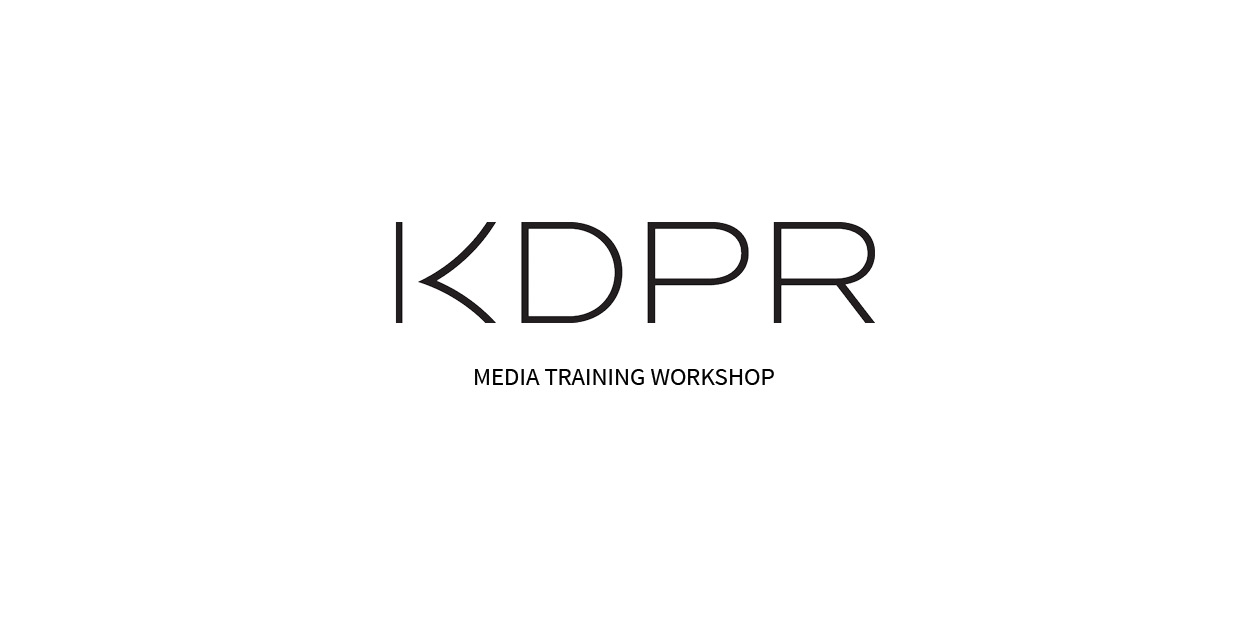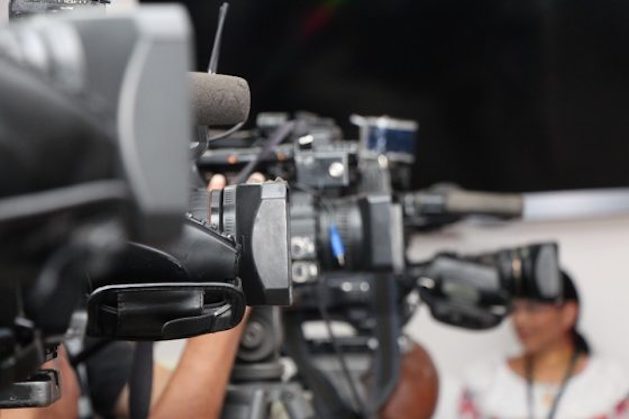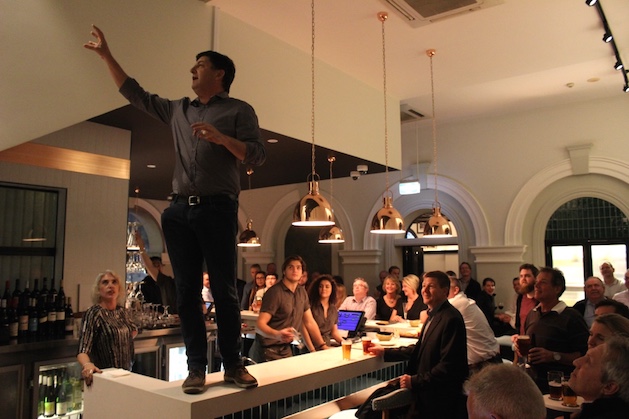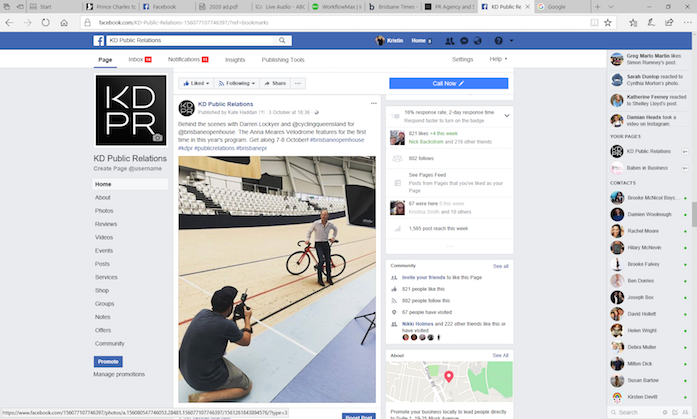-
Upcoming Media Training Workshop
Make 2018 the year you step forward and deliver your message with confidence and cut-through.
Join us for a 3 hour workshop covering how to build a media profile, interview techniques and presentation skills in 308 Queen Street’s Heritage Boardroom. Our experienced media trainers and PR experts are well positioned to help you understand how the modern media works as well as teaching techniques to deliver you message effectively and with ease.
Monday February 5
9am-12pm
308 Queen Street, access via 88 Creek Street (C2 in lifts)
$495 per head
The workshop will assist you with:
- Understanding how media works
- Planning a PR Campaign
- Preparing key messages and QAs
- Understanding what makes a good media communicator
- Handling difficult interviews
- Public speaking strategies
- Use of voice and body language
Call us on 07 3136 2555 or email to reserve your place!
-
A Queensland summer narrative
Call me un-Australian, but I don’t know the difference between a leg-bye and a follow-on, and the thought of sitting in the blazing sun for 12 hours waiting for something to happen out in the middle gives me a really bad headache.
But this week I’ve found myself turning ABC Radio on every time I sit down at my desk or jump in the car, smiling when I hear the Ashes telecast on a young corporate’s smartphone while he has lunch with a mate, and strangely enjoying getting caught in the First Day traffic log jam at 10 to 10 on Thursday morning.
It got me thinking about how much this time of year means to so many people who have toiled away in their various places of work all year, and how this week marks the transition into our glorious long languorous summer months ahead.
Yes, we are all still working at pace to finish 2017, and it is a testing time with deadlines looming and energy levels flagging, but the little distractions, the small celebrations, sustain us through to Christmas.
For me, I’m thinking a bit more cricket on in the background, a bit more rhubarb from the commentators, might be part of the musical mash-up at KDPR, when Bing, Mariah & Buble get dusted off ready for next Friday, 1 December. Look out!Signed,
Kristmas Devitt -
The power of presenting, some tips to try
I had the pleasure, the privilege indeed, of interviewing Australia’s Chief Scientist Dr Alan Finkel AO on stage at this morning’s AMCHAM Business Briefing, and apart from his Olympian brain and encyclopedia of accomplishments, what really struck me was how powerful a communicator he is.
This is a man who has an extensive science background as an entrepreneur, engineer, neuroscience and educator. He is an inventor, an investor and one of this country’s great thinkers. But guess what? He held that room of 200 plus, using the power of storytelling to bring complex policy and science to life, making the topics he covered interesting and entertaining.
It served as a reminder how important communication and presenting skills are, regardless of what area we specialise in. If you can’t communicate it, how will you convince an audience, a market, a Board, a stakeholder to come around to your point of view?
Working with senior executives to polish their presenting skills is one of the favourite parts of what I do here at KDPR. It is so rewarding to see highly talented people, leaders in their field, grow in confidence in their speaking skills and become more accomplished presenters. Today I thought I would share a few of my key tips you may wish to try, for making every presentation count and becoming a speaker with whom people really connect:
1. Engage the audience from the start
People are in the room to hear what you have to say, but as opposed to a written report, they also want to feel like they have an opportunity to get to know you a little better. So take the time to smile, to make eye contact with a few people in the audience, to bring them in with some humour and warmth before you launch into the detail. If you know someone in the room and you can relate a point to their business, all the better.
2. Let your body do the talking
It’s true that it’s not what you say but how you say it. Yes, you can have the best data and graphs to back it up, but if your voice and non-verbals aren’t reinforcing your position with confidence and enthusiasm, it can all be lost on an audience. Especially one that has been there since 6:45am on a Friday morning. Dr Finkel moved about the stage and used natural gestures to reinforce his point. He even rearranged the furniture and reassured the audience he was an engineer so it was all good. We are not robots, be animated, be expressive, connect with the other humans in the audience.
3. Self-editing
Dr Finkel had a 20 minute window to present a summary of his Finkel Report, which was two years in the making, and discuss Australia’s opportunities with Electricity. That’s a lot of content to squeeze in to a short presentation. But this is not the forum to go through every line item of the full report. Far better to present key elements well than try to cover it all. When I work with executives on content, we develop a structure that can be adapted to different time lengths, so the presentation is always ready to go.
The biggest challenge for most people with public speaking is to venture outside your comfort zone. But I can assure you, done in a safe environment, trying some new approaches to your presenting style will deliver dividends you will not believe.
-
ARTIFICIAL INTELLIGENCE JUST GOT REAL
How artificial intelligence has influenced a communications professional’s day.
Although the term ‘artificial intelligence’ may cause many to think of high-tech robots taking over the world, the reality of this concept is far less terrifying.
Siri and Google Now are both household examples of artificial intelligence, so as mentioned – nothing to do with extraterrestrial life.
Much like our homes and everyday lives, in our contemporary tech-embraced society the media and communications industry is consistently transforming.
In all aspects of our jobs, innovative technological developments are providing communications professionals with unprecedented opportunities to connect with their desired audiences.
The goal of effective communications is to influence an audience’s attitudes and beliefs. So in a world where artificial intelligence exists as a key resource in informing the direction of communication tactics and discovering their success in influencing, as communications professionals we’ve struck gold.
Artificial intelligence developments in media monitoring, social media analytics, and algorithms like google analytics and SEO are all providing data-driven insights that essentially help shape strategic communications campaigns and ensure their success.
In this context, artificial intelligence is basically enabling communications professionals to approach creative endeavours through a more calculated and educated approach.
Although these innovative technologies often come at an initial high cost, the benefits including increasing productivity, efficiency and success prove to be well worth the investment.
However one thing these technologies cannot do is think creatively!
While artificial intelligence is proving a key tool in helping PR professionals better understand audiences, we need to continue putting our creative hats on to develop the how in this equation.
Creative campaigns and key messages don’t write themselves, and analytics can’t pinpoint the strategic tone and context communication strategies should mirror – proving the value of human connection in PR.
The interaction between human creativity and intelligence, coupled with artificial intelligence is something we’re excited to continue embracing and learning from.
At KDPR we’ll continue to apply these technologies, analysing the data they provide to hone our creative strategies, key messages, and tactics to keep making big wins for our clients.
-
Communicating in a crisis: Quick and strategic messaging
We can’t predict a crisis, however we can prepare. Whether it be a business crisis or a natural one, communication is key. The question is, what is involved in a strategic crisis communications plan and what is the best strategy at the time?
Here, we discuss with you quick messaging and strategic messaging, how they complement each other and what purpose each have in a crisis.
Quick messaging:
This is where social media and digital platforms really come in to play.Quick messaging means you can reach a broad audience in a short amount of time.
It also allows for real-time updates and push alerts. In today’s fast-paced 24/7 news cycle, the ability to communicate in real-time, directly to stakeholders and publics, can be the difference between a significant crisis event and minor blip, when handled immediately.
The use of social media in a crisis also allows multiple touch points for people to communicate with the company.
Strategic messaging:
Having a strategic plan doesn’t mean it isn’t face paced, it is just a more streamlined approach to the messaging.This includes drafting key messages and disseminating them to spokespersons in the organisation. Ensuring all spokespersons are trained in media and presentation is a valuable asset and investment in your company that can limit risk and stabilise a crisis.
Having a strategy also means you have the time to set in place proper monitoring systems such as media monitoring and social media mentions.
What has your company done to prepare for a crisis?
Every crisis is different and each need to be handled as such. With preparation and a mixture of both quick and strategic messaging, your company is on the front foot of any crisis.
Not having a planned approach can have some major effects on the business.
An absence of adequate internal and external communications could mean:
- Operational response may break down
- Stakeholders are left unaware, creating unnecessary disruption in an already tense and busy time
- Company reputation can be questioned and even damaged
- If the issue isn’t addressed straight away then it can often become worse and too complicated to fix with long-lasting effects
- The businesses bottom line may suffer
KDPR are experts in handling a crisis and strategically planning ahead. If you have any questions about crisis management give us a call, we’d be happy to talk you through our processes.
-
We love a good story
From our early childhood, we develop a love for stories and the lessons they communicate. Regardless of the delivery, stories convey messages in an entertaining, memorable and indirect way. But great stories can influence feelings, beliefs and behaviours. A team of scientists discovered a neurological connection between stories and the area of the brain responsible for empathy, compassion and cooperation. These feelings tend to increase when we are told stories which resonate with us.
By using storytelling, whether it be videos, case studies or testimonials, you can strengthen your brand messages further and create an emotional connection to audiences.
Recently, well-known brand Seek used storytelling for their ‘Why Settle?’ campaign. The campaign advertisement is a social experiment focusing on three Australians whose family and friends identified as unfulfilled in their current career. The experiment runs with the tagline ‘Why Settle? Seek’ and aims to show consumers the difference it can make when you have job satisfaction. The advertisement records the moment Ned, Lee and Charu are surprised by their families and friends who picked a new job best suited to them. Seek arranged a day of hands-on work experience to help uncover their true potential. This created a strong, emotive story and gave the audience a sense of journey and connection.
Furthermore, Seek developed a campaign website which tells stories of people who have experienced careers changes otherwise known as the ‘non-settlers’. The purpose of this campaign was to give Australians the confidence to discover the career that’s right for them.
Although it sounds simple, storytelling can be a complex and powerful communication tool. When implemented effectively, storytelling instantly humanises your brand and engages your target audience.
At KDPR, we’re all storytellers and eager consumers of content. We can take your brand content to the next level and engage your consumers in a completely new way. Great stories are not accidental; they are carefully strategised and executed with a detailed understanding and knowledge of the skills we use to tell them. Great stories will be memorable and are an effective way to draw in a consumer.
So, what’s your story? How can KDPR tell it?
-
Why Instagram can be more than just holiday and fitness photos
When Instagram began as a lowly image sharing app in October 2010, few outside of the app’s creators could have predicted the social media channel would have such a significant impact on the future of communication and business. Having grown to 100 million active users by April 2012, the potential was beginning to be realised.
What began as simply a free mobile app to share images with your social network, quickly become one of the most successful avenues for business (and individuals) to promote and shape their brand and public perceptions. While social media has been accused of providing a platform for egoism and manufactured reality, the channel is about more than extravagant holidays and unrealistic fitness photos.
Instagram is a branding playground for businesses that know how to use it to their advantage. The platform is full of people who are excited to engage with visually appealing content. Businesses have begun to skilfully tap into this goldmine and use their presence to establish a brand and name for themselves among a very powerful and diverse audience.
While businesses are currently benefitting from the exposure presented by Instagram, experts in the field of communication predict that businesses that do not get on board the social media band wagon, will not survive.
Not only does Instagram help to make your business ‘pretty’, Instagram provides yet another opportunity for you to engage and communicate with some of your most important stakeholders. We know how important that is when our audiences expect engagement.
We know what you’re thinking. So, I not only have to establish a successful business, I have to constantly communicate with the market AND the communication must be engaging and exciting?! It can be daunting for many business owners but the best way to show your audience that you are a forward thinking business is to engage in a technologically advanced way.
The most important thing for businesses to remember is that not every post is going to (or has to) sell your product. While you may post periodically about products you have for sale, ads don’t always engage people. Create content that uses your products in an exciting way to interest your audience. Yes, you can include detail on purchasing the product (or your key message) at the end of your caption, but it should not be your sole message.
The purpose of using Instagram is to establish a following that will promote your business for you, which will lead to trust and credibility, resulting in sales for you. Research has shown that buying behaviour has changed. People shop online, but rely on social media comments and online reviews to gauge if they will purchase a product. Therefore, your following will become very important in selling the message you have to share. It is therefore essential that you gain their trust and they will, in return, establish credibility for your brand and message.
With this in mind, it is easy to understand why there are now professionals trained purely to manage and conceptualise business social media profiles.
Instagram is powerful; use it to your advantage!
-
Stunt activations are no quick gimmick
For companies willing to be a little creative and push the limits, stunt activations are the perfect way to take their brand to the people and the next level, all whilst creating strong leads and interactions with their target demographic.
We all know of a stunt gone wrong, or an attempted quick gimmick by a company, that has significantly backfired – but a well-executed, sophisticated activation can achieve very real and tangible results, elevating and positioning a brand in new light and attracting new customers.
The Red Bull Stratos stunt is known world-wide and created immeasurable cut-through for the brand, resulting in a hundred million cumulative views on YouTube. Everyone held their breath as Felix the astronaut jumped from space, free falling until he landed on the ground some 40 kilometres away. On Huffington Post alone we counted 18 articles about the event. The stunt even spawned a documentary “Space Jump” on National Geographic. The result of Stratos was a significant increase in Red Bull’s brand prestige, cementing themselves as an industry leader in energy drinks.
The truth is, you don’t need to jump from space to pull off successful stunt activations. The team at KDPR conceived and executed an “Unforgettable Proposal” event in Queen Street Mall for Valentine’s Day this past week. While not quite as adrenaline-charged as Stratos, it was successful in generating hundreds of thousands of impressions, interactions with the client’s brand and adding numerous potential new clients directly into to their database.
So what are the common themes of successful PR stunts? Firstly, they’re out of the ordinary and are specifically designed to create a sensory or emotive reaction from the target demographic. They also have a creative premise that relates directly to the brand and the brand’s personality. For instance, Red Bull associates itself with extreme sports and adventure, so jumping from space takes the brand to new heights…quite literally. Finally, these events had PR firms and practitioners behind them who ensured smooth logistics, brand alignment, audience engagement, partnership negation and delivery as well, of course, as media coverage.
So if this has you excited to extend your brand a little further and contemplate how a stunt activation could work for your company, please give us a call. We promise we won’t encourage anyone to do a space jump 40 kilometres above the earth’s surface but we can’t promise the concept won’t be just as exciting.
-
Are digital tactics just for a millennial audience
There is something particularly intriguing about the interconnected world we find ourselves in. We are connected to hundreds of people every day by our mobile devices, social networks and even our watches.
On any street, almost every person walking past is, in some way, connected to technology. Whether they are attempting to text and walk, have earphones peeking out from their hair or have a tablet tucked under their arm, we are all increasingly reliant and dependent on technology.
However, something equally surprising is that these users are not just millennials. People of varying ages are becoming more accepting of technology and this is, inadvertently, changing the way businesses operate. While some grandparents may continue to fear and be suspicious of technology, it seems that the ‘tech-savvy’ audience we hear of so frequently has changed.
This poses the question, if a wider audience is now becoming accepting and engaging with the digital world, are digital tactics still only relevant to the millennial audience (generation born from 1980’s-early 2000’s)?
In short, no. Not anymore, not exactly.
Like everything that isn’t black and white, neither is this. Every business is different, which is why it is always important for businesses to have a clear target audience for their key messages and Public Relations campaigns. It may seem like an easy and obvious step in developing any business, but you may be surprised that this is a step many businesses skip or don’t give adequate consideration.
Curated Digital said: “The traditional world of communications is slowly being taken over by technology and at the forefront of this change are the millennials; paving the way for creativity and experimental content.”
While this statement provides insight into the future of communications, we are already seeing aspects of this emerging. For example, Dove is a creative (and successful) example of how thought-provoking campaigns work for a digital audience. Their ‘real beauty’ campaign is innovative and has engaged a wide audience of varying ages, through their use of diverse talent.
Advice for businesses incorporating digital tactics, regardless of their target audience, is to ensure they are building relationships with their audience, not just regurgitating content. The digital world is challenging businesses to rehash the way in which they think about PR and it’s a very exciting world to be part of.
So, while the millennials may hold the largest share in the digital marketplace at the moment, expect that to change and be ready when it does. Research already shows millennials don’t respond to online ads, so it is only a matter of time before this trend of online advertising is supplemented for engaging PR content.
A word to the wise: Be aware of your audience, be prepared for the digital market and go forth and conquer!
-
Leveraging Facebook’s new features: Facebook live and story
Facebook recently introduced new features: Facebook Live and Facebook Story. Both features incorporate video content in a slightly different way than just uploading a new video. Of course, both features has its upside and downside. Now, what are they, and how can we use it in PR?
Facebook Live
This feature enables the user to broadcast live videos, directly to their news feed and their story, from their devices so their followers on Facebook can watch the video as they record it! Another upside is that friends and followers get notified when you start to go live, so it is more engaging than just uploading videos. Viewers can still leave comments, likes, or share the video as it’s being broadcasted, which leads to better interaction with the audience.
Broadcasting live videos can be risky – what if something goes wrong? Hence, preparation is critical. Run your script and do a practice video to minimize the risk!
Facebook Live could be a suitable option to broadcast an event, allowing anyone to access and be involve in the event from anywhere.
Facebook Story
This feature allows user to share short videos instantly, with lots of editing option (fun filters, text, geotag). Unlike Facebook live, your story will only be accessible for 24 hours after you post it and viewers can only respond with direct message – messages are not made public, therefore Facebook Story is more suitable for direct interaction with individuals.
Given its short availability on the internet, try not to rely on this feature for important announcements and information if you don’t have a huge following. However, Facebook Story is great to keep you Facebook account active and interactive! It’s also great for ‘behind the scenes’ of your project or event. It may work as a ‘teaser’ video to build people’s curiosity and strengthen the buzz.










